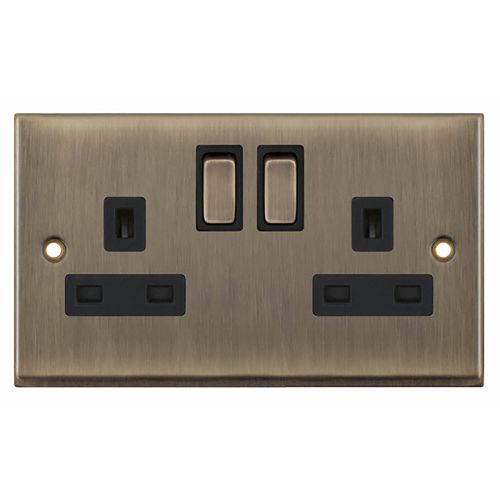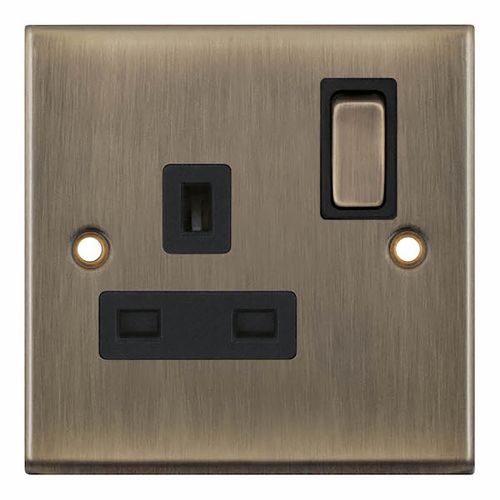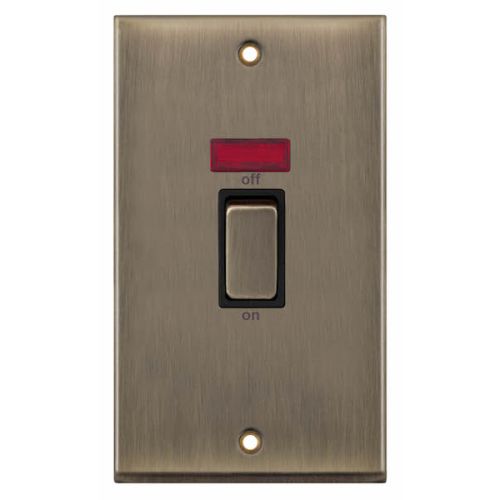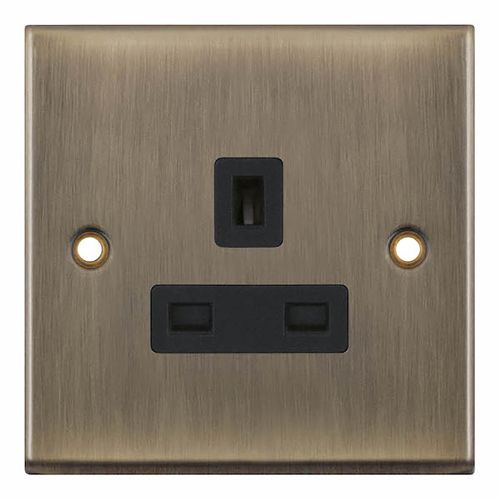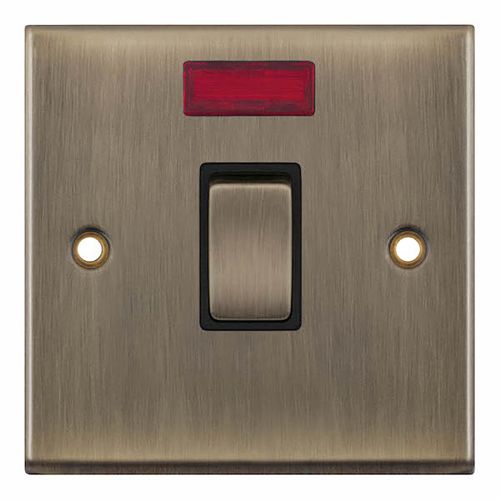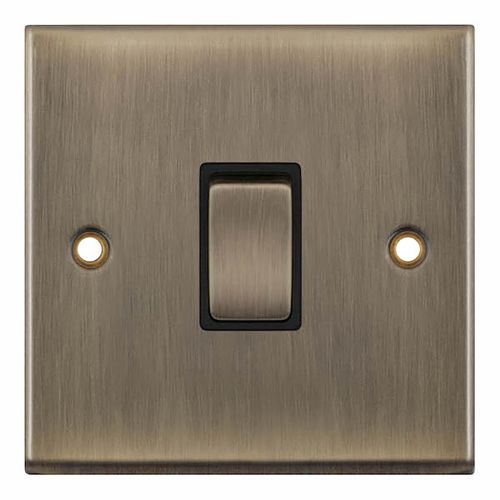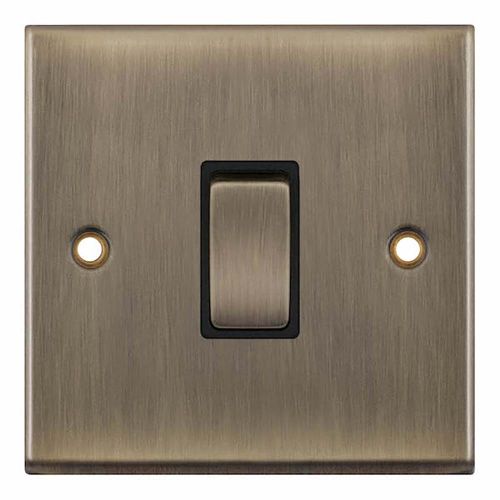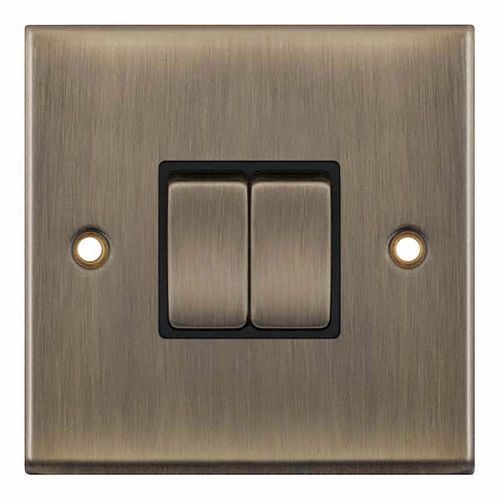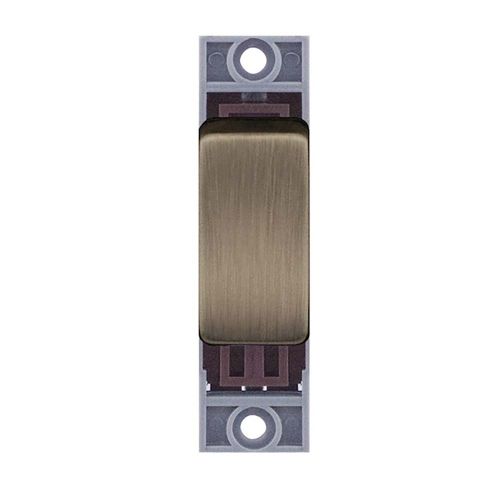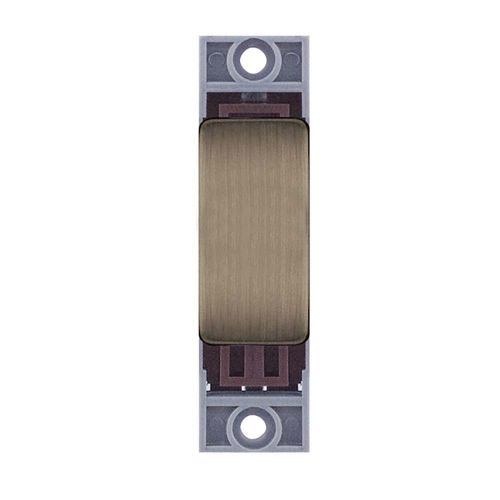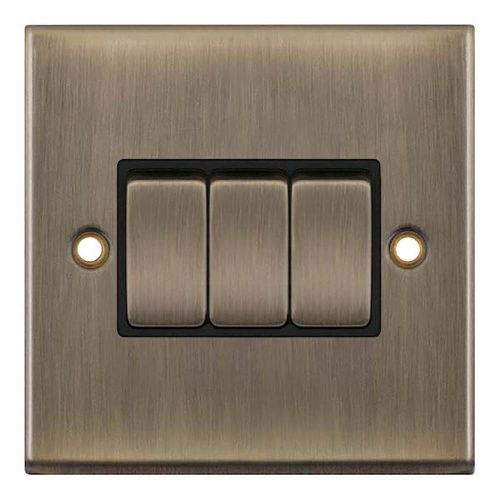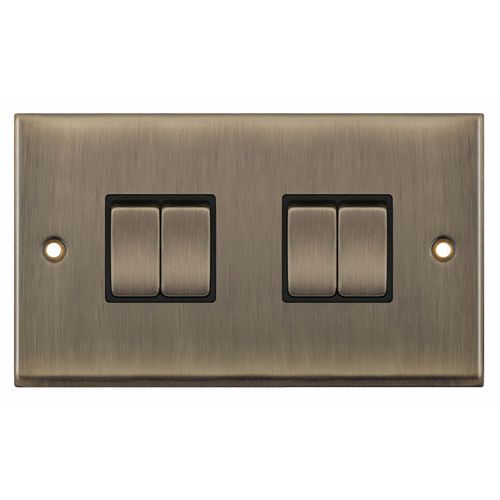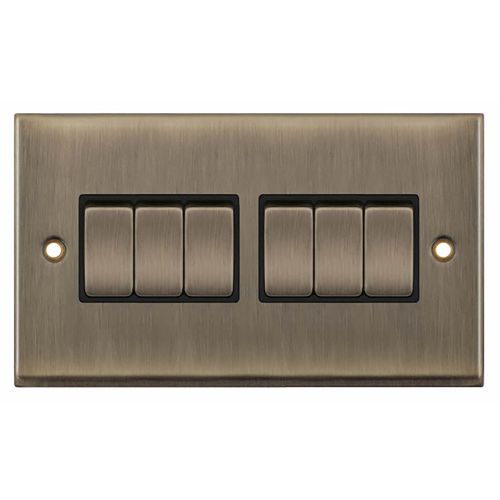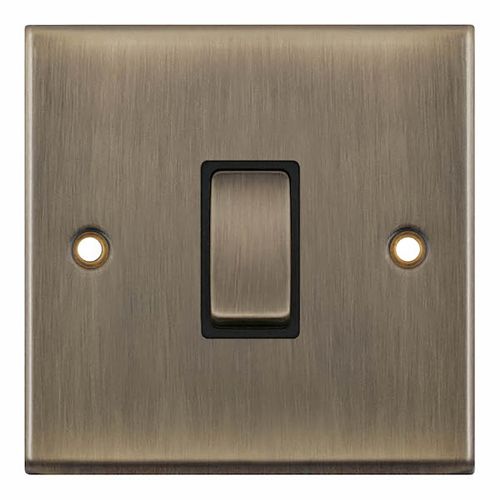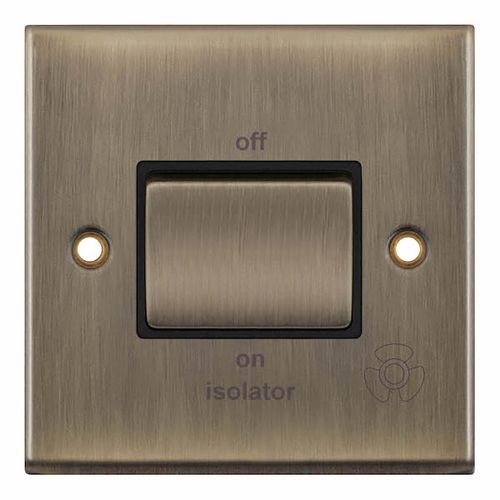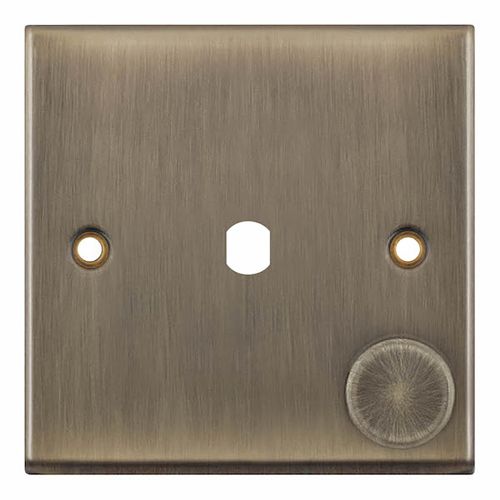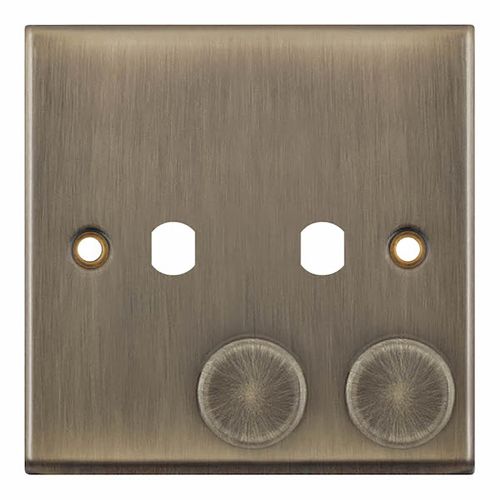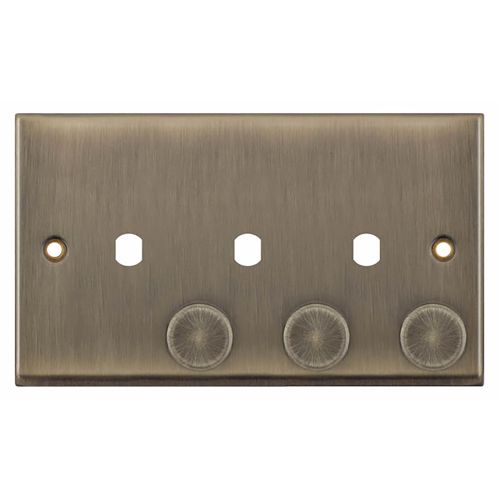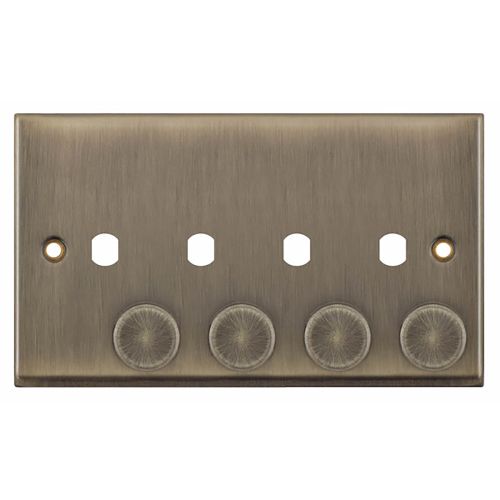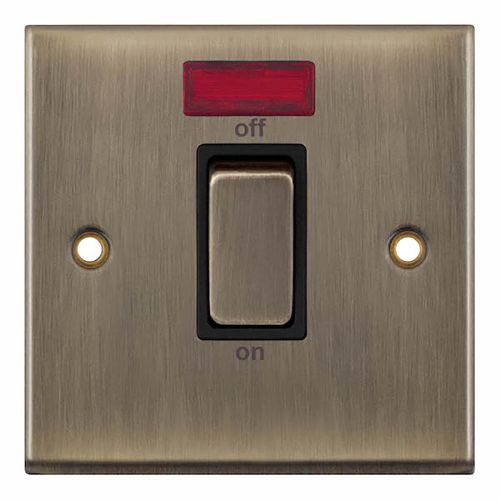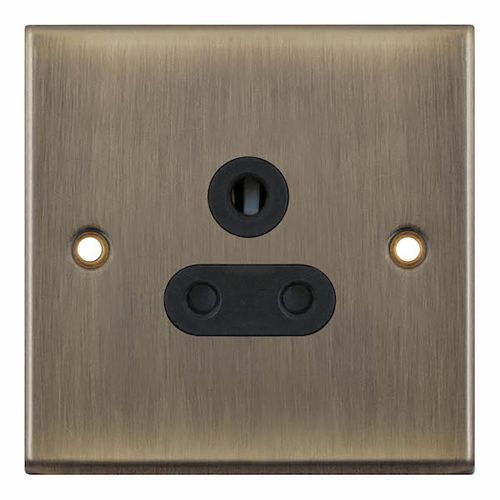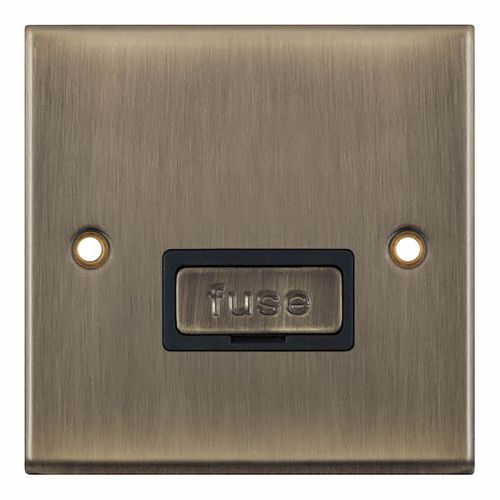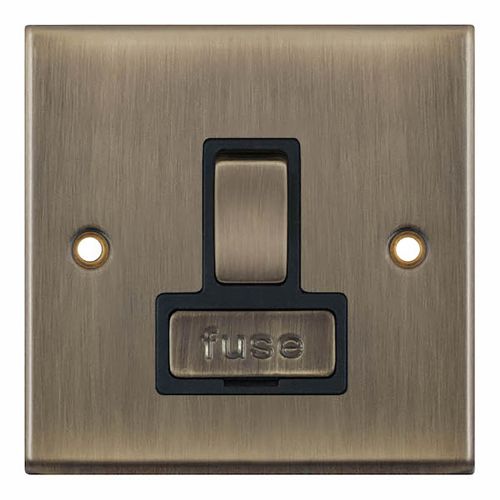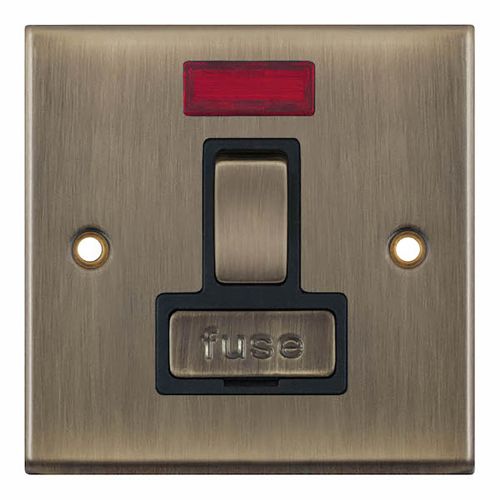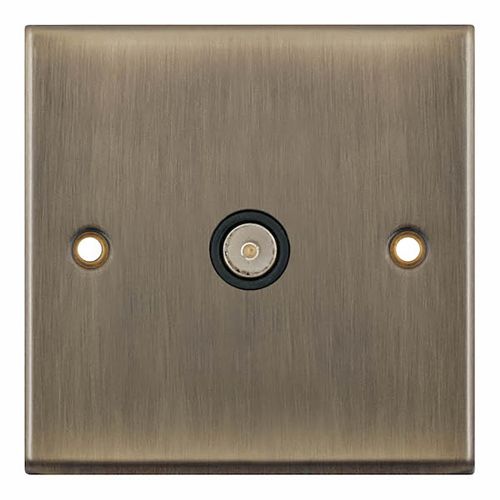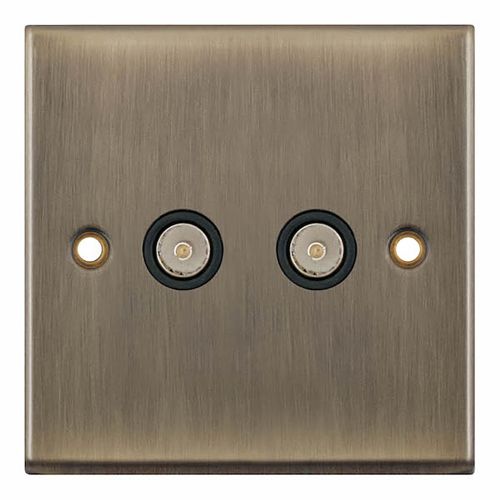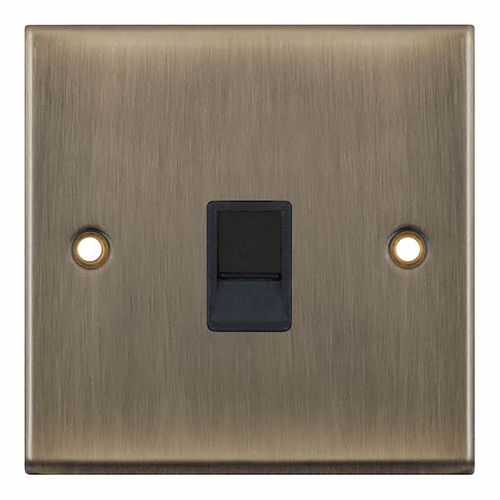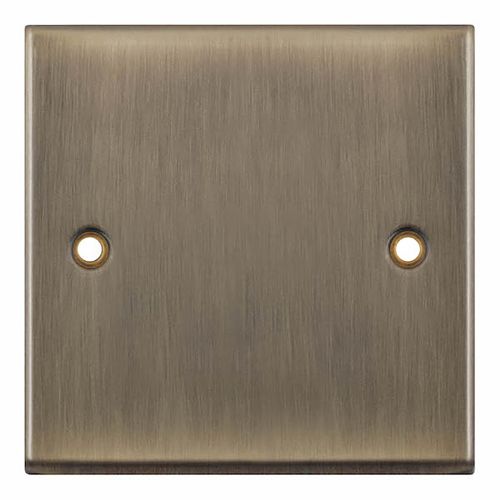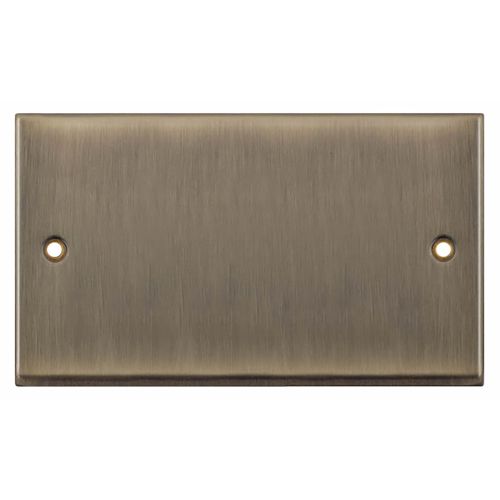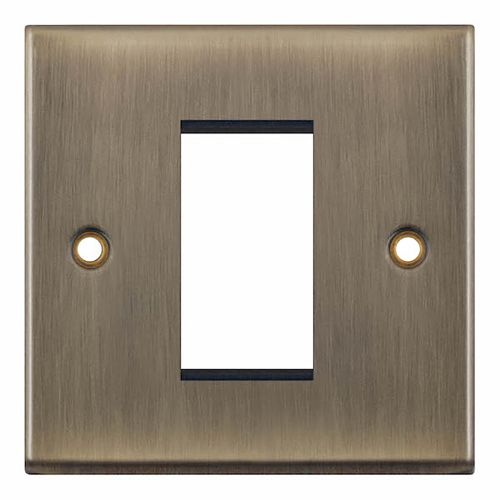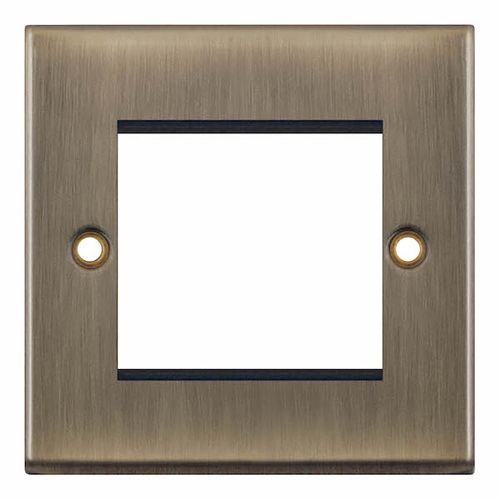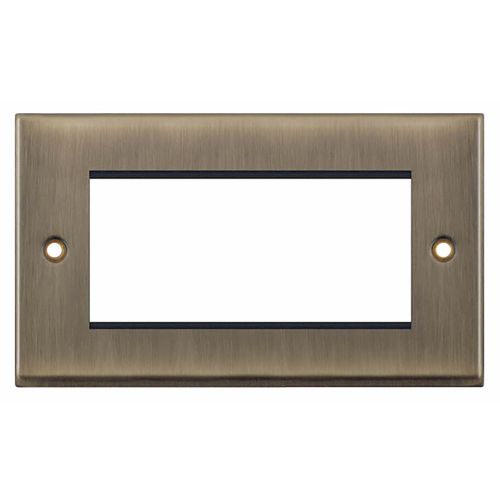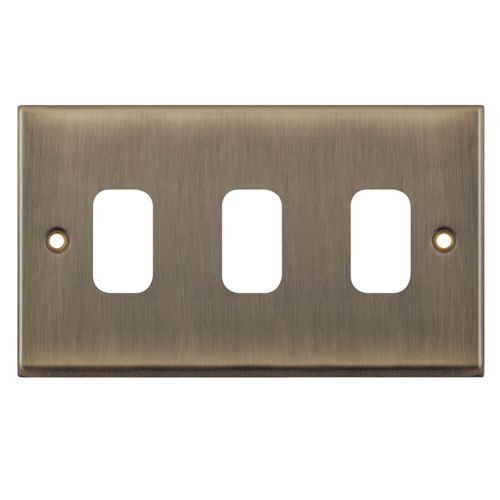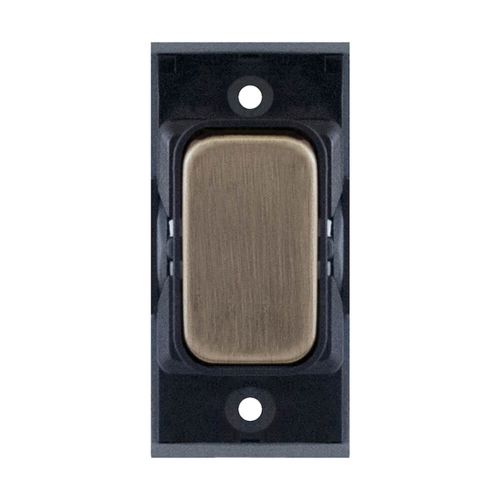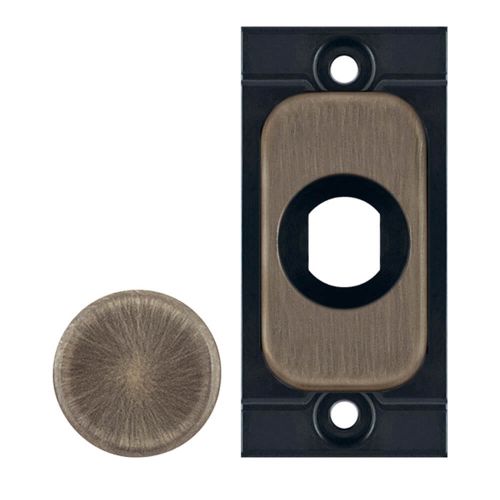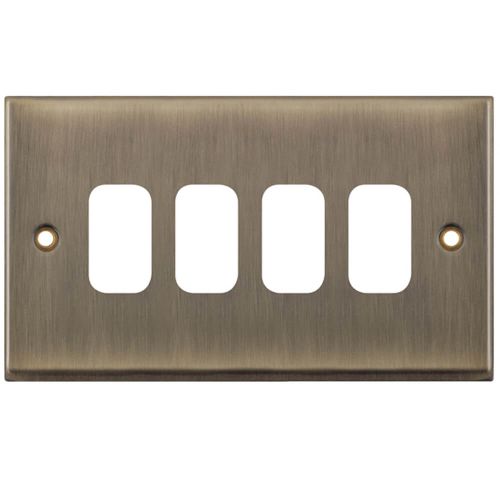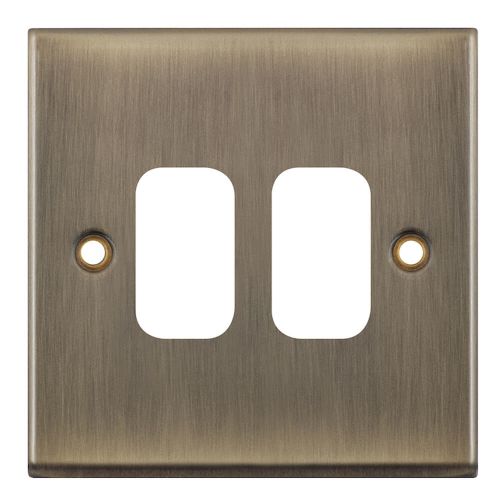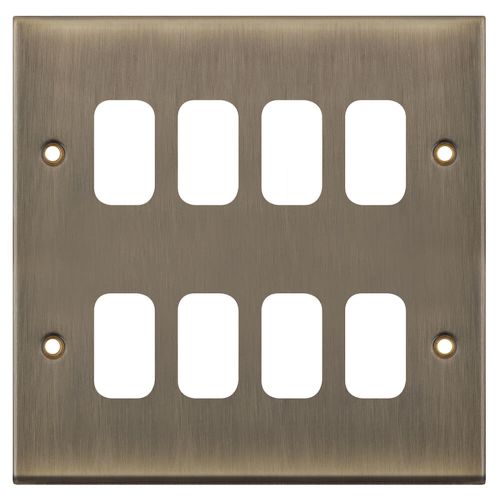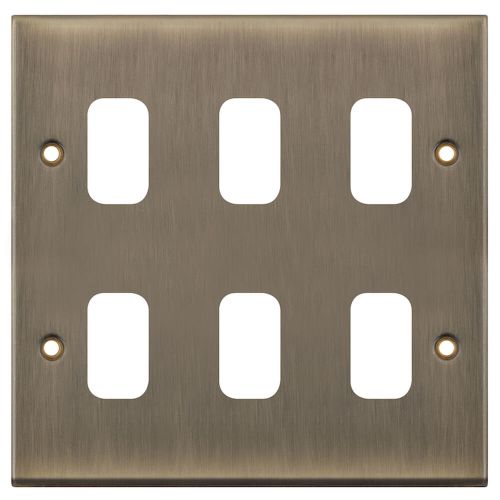Antique Brass Sockets & Switches
At Meteor Electrical, we have a wide variety of sockets and switches in Antique brass texture and finishes from Selectric to complete your home or business. Antique brass has become increasingly popular as the finish provides a traditional and elegance appearance with the dark brass brushed effect.
Our Antique Brass range includes antique brass light switches, sockets, dimmer switches, USB sockets, euro modules, blank plates, tv points, telephone points, antique brass cooker switches, and so many more to choose from! The range is only available with black inserts.
Need help? Contact our friendly sales team on the live chat, we would love to help you complete your home or business.
Order our antique brass range online for next day delivery!
Antique Brass Switches & Sockets
Antique brass sockets and switches are popular in many households due to their elevated appearance. Often standard white switches and sockets bring down the appearance of rooms. Due to this reason, many homeowners seek out antique brass wall sockets and switches to improve the aesthetic of their rooms.
At Meteor Electrical, you can find a wide range of antique brass switches and sockets to meet your wiring needs. Such antique brass electrical sockets and switches require some extra care. You must maintain the brass electrical sockets so that they last long. Here are some important things you must consider before installing antique brass sockets.
What Are Antique Brass Socket And Switches?
Antique brass switches and antique brass sockets work similarly to regular switches and sockets. The one thing that sets antique sockets apart from other sockets is their finish. Antique brass switches and sockets are the best way to bring colour and elegance to your regular electrical outlets. Such antique brass sockets are a great way to add character to an ordinary room.
Antique brass switches have a beautiful and elegant finish, elevating your room’s decor. Antique brass sockets fit well with both traditional and modern homes. This quality makes antique brass sockets versatile as they have the ability to elevate the decor in any room.
Many interior decorators and homeowners prefer antique brass sockets and switches over regular sockets and switches as they add to the house’s decor and aesthetic. Antique brass sockets have a sophisticated finish, and the elegant switch plate blends in seamlessly on your walls. These types of antique brass switches and sockets don’t look jarring in your living space.
Antique brass sockets and switches are available in multiple configurations depending on your wiring needs. There are antique USB plug sockets, light dimmers, light switches, and other antique brass electrical sockets.
Out of all the different finishes for antique brass sockets, the most commonly used finish is the aged brass. This aged brass finish is commonly used in traditional household properties but can also work for modern household properties or homes with modern decor.
Antique brass switches and sockets are aged using either raw brass material or raw brass plating. The raw material is treated to create a finished look. After this process, the antique brass sockets and switches have an aged and elegant finish.
Many antique brass sockets and switches have a slightly golden undertone or a rich brown tone. These tones are characteristic of the aged brass look. However, it is important to note that not all antique brass switches and sockets look the same. Some antique brass sockets have an aged finish which means that these brass electrical sockets don’t have a high shine. These antique sockets have a matte finish.
Polished antique brass sockets tend to be shinier, and it hides blemished much better. When compared to satin brass or brushed brass, antique brass has a slightly less golden appearance. You can find a wide range of antique brass sockets and switches at Meteor Electrical. These antique brass switches and sockets come in multiple configurations to fit all your wiring needs.
When you are looking to buy antique sockets, make sure to get high-quality items. High-quality antique sockets last longer than antique sockets with low-quality manufacturing. The main reason to use antique sockets is their luxurious finish; therefore, low-quality antique sockets with poor brass finishing will ruin the look of your house. The low-quality materials might also need repairs quickly, and they could damage your home’s electrical wiring systems.
What Colour Works Best With Antique Brass Sockets And Switches?
Before purchasing antique sockets, it is important to look at how a room’s colour scheme works alongside the antique sockets. Since most antique sockets have a traditional or vintage finish, they work well in households with similar decor. However, you can also add brass electrical sockets to modern homes. These brass electrical sockets give the contemporary household a warmer touch.
When it comes to the colour scheme, it is best to avoid putting antique brass electrical sockets in bright or neon-coloured rooms. Instead, you should opt for a simple colour scheme. Brass electrical sockets can be added to monochromatic black and white decor. You can also install brass electrical sockets in rooms with a dark or deep colour scheme.
Brass electrical sockets also look good in the bathroom and kitchen with white tiles. If you have high-quality materials such as marble leather and suede in your rooms, you should add brass electrical sockets for an added luxurious look.
If you have a plain white or neutral colour scheme in your home, you can still add antique brass switches and sockets. These antique brass switches and sockets will add some colour to the otherwise neutral colour scheme. However, it’s important to add comfort to the luxurious decor, so you should add soft textures to ensure that the brass electrical sockets don’t look too jarring.
What Are The Different Finishes In Antique Brass Sockets And Switches?
Antique brass sockets come in a variety of finishes, and each finish has its unique quality that adds elegance to your house’s decor. Since there is a wide selection of antique finishes, it is difficult to know which finish works best for your home decor. Here are some finishes available on the market.
Satin Brass
Satin brass or brushed brass plug sockets tend to have a smooth matte finish. These brass sockets have a distinct brush mark on their finish which sets them apart from other brass finishes. Satin brass sockets look smooth and subtle, yet they still have a bold quality that makes them stand out. Satin brass is a choice for households as they hide several blemishes.
Satin brass sockets don’t show water spots and fingerprints. This finish does not corrode or tarnish after a long time. The colour is bright without looking too out of place. This type of brass switches and sockets work well with modern or contemporary interiors.
Antique Brass
Antique brass is one of the most common types of brass switches and sockets. These types of antique sockets have a deep, rich brown shade, and they have golden undertones. This subtle finish in antique brass sockets looks warms and is similar to natural brass materials. Antique brass sockets are specially treated to have an aged look.
Antique brass sockets work well in colonial, victorian, and other vintage-designed homes. Vintage antique brass sockets are a great way to add warmth to your room without making them feel dated. Even though antique brass sockets have a vintage aesthetic, they also work well in modern homes.
Polished Brass
The polished brass finish is bright, shiny, and very reflective. A polished brass finish is considered a classic when it comes to brass switches and sockets. Since polished brass has such a reflective finish, they are highly visible in any room.
Polished brass sockets in traditional rooms. Polished brass electrical sockets are easy to clean and maintain. These sockets are widely available on the market. Despite the bright look, this finish has several downsides. Polished brass is more likely to show fingerprints, watermarks, and damage than matte brass finishes.
Antique Brass Vs. Antique Bronze?
Antique brass is often substituted with antique bronze. Even though these two materials have a similar appearance, they have completely different properties. You might mistake an antique bronze socket for antique brass switches. Here are some important differences to bear in mind between antique brass and antique bronze.
Brass is a highly reliable material that has been around for centuries. Due to its strength and strong resemblance to gold, brass is often used for jewellery, current and decorative statues. Some common uses of antique brass include lighting fixtures, doorknobs, fireplace equipment, switches, and sockets. Antique brass or standard brass is a mixture of copper and zinc compounds. Early brass items only contained 20% to 80% of zinc. However, modern brass objects such as antique brass sockets may contain other elements such as lead or nicked for added strength.
Bronze, often mistaken for brass material, is an alloy of tin, copper, aluminium, and other metals such as manganese. Bronze tends to have a yellowish hue, but brass looks more coppery and gold. However, both materials are prone to tarnish after prolonged use. It is possible to have antique brass sockets last long if they are maintained well.
Antique brass can be polished for a warm and bright shine, but bronze develops a darkened patina that is difficult to lighten. Due to this characteristic, bronze is much different from brass. Since bronze develops a dark patina, you should opt for brass sockets and switches.
Here are some features to look for in order to distinguish between bronze and antique brass sockets.
- Antique brass has golden undertones.
- Antique brass sockets and switches are not magnetic
- Antique brass shows signs of natural imperfections. These imperfections appear due to use, age, or cost of production. You should expect some scratches, tarnish, oxidation and discolouration.
- Antique brass switches and sockets have a vintage appearance compared to bronze.
- Antique brass material is heavy.
Another great way to differentiate between brass and bronze metal alloys is by evaluating the tarnish on your brass or bronze object. Bronze items tend to have a brown shade tarnish, while brass tarnish turns the object black. Another indicator of these alloys is the colour and how it reflects the light. If the object is yellow with a bright and shiny finish, it is more likely to be brass instead of bronze.
How To Clean And Maintain Antique Brass Switches And Sockets?
To make sure that your antique brass switches and sockets last long, it is important to regularly clean and maintain these switches. Antique brass sockets only need gentle cleaning for maintenance. Avoid using chemical or abrasive cleaners on brass surfaces as they ruin the shine and texture of the brass.
The lacquered brass surface should be wiped clean with a soft cloth. You can use a non-abrasive polish for cleaning if needed. You may use warm water to clean; however, avoid going near electrical components and opening with water as this might give you an electric shock.
How To Install Antique Brass Switches And Sockets?
With standard switches and sockets, there is always some assembly and instructions required. With antique brass sockets, extra care should be taken to protect the brass surfaces.
While you should consult a qualified electrician before working with light fixtures, you can still try to maintain and repair switches and sockets. Before installing antique brass sockets and switches, here are some important things to consider.
Safety Measures Before Installing
Before working on switches and sockets, it is important to undertake certain safety measures. Not only do these safety measures ensure your protection from hazards, but they also protect your wiring system. When it comes to electrical work, safety is crucial. When handled or tampered with incorrectly, electricity is fatal. If you are inexperienced in electrical, consult a qualified electrician.
Before starting installment work on your new light switch or socket, you must switch off the power from your working space. To do this, you have to find the fuse box and circuit breakers. Household lighting will generally align to one or more circuits, and these fuses are labelled with clear identifiers.
Once you identify the correct fuse, switch it off. For added safety, you can switch all the power off. You must also ensure that the switch or socket you will work on is completely powered off with the testing equipment. Use a voltage tester for lighting and a socket tester for other switches and sockets. These tools will give you a clear indication of the power status of the electrical socket.
Also, ensure that no one else in the household will switch the circuit's fuse back on, or someone might unscrew the existing fitting. Make sure that the inside of the socket area is dusted and clear to avoid debris getting in the way of the electrical work.
Always make sure to have the appropriate tools for the jobs. A screwdriver is one of the most important tools for this kind of electrical work. Have the proper screwdriver end with you to avoid any hindrance in the installation process. Keep extra screws and wall plugs on hand in case there is any need. Some installations might require a hammer drill or wire stripper. Check the requirements for these tools before you start the installation job.
Installing An Antique Brass Switch
When installing an antique switch, familiarise yourself with the inner working of the component. Once you acquire the antique switch, you will have a faceplate and an inner plate. The inner plate is the mounting box.
Remove the existing faceplate component from the switch area. You can remove the existing faceplate by unscrewing the simple screws. Keep these screws to one side. Before installing a metal switch, in this instance, a brass switch, you must earth your wires.
Earthing your wires is important as it reduces the chance of getting an electric shock or other electrical hazards. Earthing the wires protects you by sending the faulty currents back to the earthing component. This process is a safety measure that is crucial for fitting and wiring any electrical unit.
Some metal switches don’t have an inner plate. In this instance, you must attach the earth core wiring to your faceplate. Make sure to familiarise yourself with the previous wiring setup before you begin installing the new switch. This will help you keep track of where each wire should be installed.
Also, familiarise yourself with the wiring colours to avoid any confusion. In the UK, the earth wire has a green colour. Remove the earth core and attach it to the new faceplate. Next, connect all the other wires to the new faceplate and switch. Secure everything with screws and power on to test the switch.
Installing An Antique Brass Socket
To install an antique brass socket, you must start with surface mounting. If you have an existing surface-mounted socket, you need to unscrew the socket faceplate and remove the wire connections inside.
Once the existing socket is removed, take the antique brass socket box and feed the wires through and into the connections. Screw and secure the new faceplate in the wall and add wall plugs if required. Make sure to handle the antique brass socket carefully, as you don’t want any scratches on the new antique component.
If you are installing completely new sockets, you need to mark the screw area on the wall carefully. Use a pencil and the new socket’s faceplate to measure and mark the socket area accurately.
Make sure that there is nothing behind the wall where you wish to screw in your new brass socket. Drill holes in the wall where you have made marking and hammer the wall plugs into position. Take great care to cut through the cable entry on the new socket box component.
Afterwards, secure the socket box to the wall with screws. If you are directing wires into your socket from a long distance, you should install trunking or conduit. This equipment will keep your wiring to the wall. After securing all the connections and fittings, you must test your new antique brass socket.
FAQ's
- What is Antique Brass Finish?
- Where is Antique Brass Switches commonly installed?
- What colours goes well with Antique Brass finishes?
- Do the Antique Brass Switches come with different colour inserts

